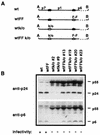Novel Gag-Pol frameshift site in human immunodeficiency virus type 1 variants resistant to protease inhibitors
- PMID: 9621079
- PMCID: PMC110421
- DOI: 10.1128/JVI.72.7.6146-6150.1998
Novel Gag-Pol frameshift site in human immunodeficiency virus type 1 variants resistant to protease inhibitors
Abstract
Human immunodeficiency virus type 1 (HIV-1) variants resistant to protease inhibitors have been shown to contain a mutation in the p1/p6 Gag precursor cleavage site. At the messenger RNA level, this mutation generates a U UUU UUU sequence that is reminiscent of the U UUU UUA sequence required for ribosomal frameshifting and Gag-Pol synthesis. To test whether the p1/p6 cleavage site mutation was generating a novel frameshift site, HIV sequences were inserted in translation vectors containing a chloramphenicol acetyltransferase (CAT) reporter gene requiring -1 frameshifting for expression. All sequences containing the original HIV frameshift site supported the synthesis of CAT but expression was increased 3- to 11-fold in the presence of the mutant p1/p6 sequence. When the original frameshift site was abolished by mutation, expression remained unchanged when using constructs containing the mutant p1/p6 sequence, whereas it was decreased 2- to 4.5-fold when using wild-type p1/p6 constructs. Similarly, when introduced into HIV molecular clones, the p1/p6 mutant sequence supported Gag-Pol synthesis and protease activity in the absence of the original frameshift site, indicating that this sequence could also promote ribosomal frameshifting in virus-expressing cells.
Figures




Similar articles
-
Contribution of the Gag-Pol transframe domain p6* and its coding sequence to morphogenesis and replication of human immunodeficiency virus type 1.Virology. 2004 Dec 5;330(1):271-83. doi: 10.1016/j.virol.2004.09.013. Virology. 2004. PMID: 15527852
-
Polymorphism of HIV type 1 gag p7/p1 and p1/p6 cleavage sites: clinical significance and implications for resistance to protease inhibitors.AIDS Res Hum Retroviruses. 2000 Sep 1;16(13):1209-13. doi: 10.1089/08892220050116970. AIDS Res Hum Retroviruses. 2000. PMID: 10957718
-
Structure-function analysis of the ribosomal frameshifting signal of two human immunodeficiency virus type 1 isolates with increased resistance to viral protease inhibitors.J Gen Virol. 2007 Jan;88(Pt 1):226-235. doi: 10.1099/vir.0.82064-0. J Gen Virol. 2007. PMID: 17170455
-
A review on architecture of the gag-pol ribosomal frameshifting RNA in human immunodeficiency virus: a variability survey of virus genotypes.J Biomol Struct Dyn. 2017 Jun;35(8):1629-1653. doi: 10.1080/07391102.2016.1194231. Epub 2016 Aug 2. J Biomol Struct Dyn. 2017. PMID: 27485859 Review.
-
Targeting frameshifting in the human immunodeficiency virus.Expert Opin Ther Targets. 2012 Mar;16(3):249-58. doi: 10.1517/14728222.2012.665879. Expert Opin Ther Targets. 2012. PMID: 22404160 Free PMC article. Review.
Cited by
-
Gag-Pol processing during HIV-1 virion maturation: a systems biology approach.PLoS Comput Biol. 2013;9(6):e1003103. doi: 10.1371/journal.pcbi.1003103. Epub 2013 Jun 6. PLoS Comput Biol. 2013. PMID: 23754941 Free PMC article.
-
Adaptation of HIV-1 depends on the host-cell environment.PLoS One. 2007 Mar 7;2(3):e271. doi: 10.1371/journal.pone.0000271. PLoS One. 2007. PMID: 17342205 Free PMC article.
-
Characterization of the frameshift stimulatory signal controlling a programmed -1 ribosomal frameshift in the human immunodeficiency virus type 1.Nucleic Acids Res. 2002 Dec 1;30(23):5094-102. doi: 10.1093/nar/gkf657. Nucleic Acids Res. 2002. PMID: 12466532 Free PMC article.
-
Modulation of HIV-1 Gag/Gag-Pol frameshifting by tRNA abundance.Nucleic Acids Res. 2019 Jun 4;47(10):5210-5222. doi: 10.1093/nar/gkz202. Nucleic Acids Res. 2019. PMID: 30968122 Free PMC article.
-
HIV Resistance Prediction to Reverse Transcriptase Inhibitors: Focus on Open Data.Molecules. 2018 Apr 19;23(4):956. doi: 10.3390/molecules23040956. Molecules. 2018. PMID: 29671808 Free PMC article. Review.
References
-
- Carrillo A, Sham H, Norbeck D, Kempf D, Kohlbrenner W, Plattner J, Leonard J, Molla A. Abstracts of the Fourth Conference on Retroviruses and Opportunistic Infections 1997. Washington. D.C: Infectious Diseases Society of America; 1997. Selection and analysis of HIV-1 variants with increased resistance to ABT-378, a novel protease inhibitor, abstr. 462.
Publication types
MeSH terms
Substances
LinkOut - more resources
Full Text Sources
Research Materials
Miscellaneous

